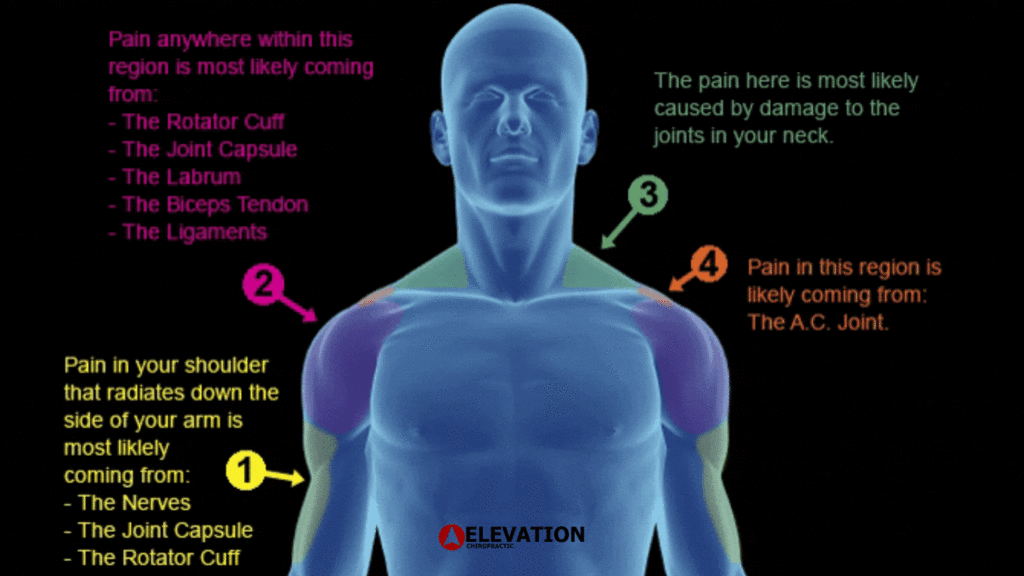Shoulder Pain Treatment: A Rowlett, TX Chiropractor’s Perspective
What is Shoulder Pain?
One of the most common complaints we hear is pain caused by issues in the shoulders. The shoulder is one of the most complex joints in the human body. It is a “ball and socket” joint, meaning that it can move in any direction. In fact, it is considered to be the most mobile joint in the body, which is helpful given the wide range of activities we need our arms for! However, because it is so mobile, it is not a very stable joint, which makes it highly susceptible to injury. For this reason, shoulder pain is a very common condition that is treated by our doctors at Elevation Chiropractic. Shoulder pain will occur in around 70% of people at some point in their lives (1 ) .

Depending on the cause of your shoulder pain, you may experience:
- Pain deep in the shoulder joint, in the back or the front of the shoulder and the upper part of the arm. Sometimes the pain in the shoulder can be described as a ‘catching pain’. The location and type of pain is likely to relate to the structure causing the pain
- Reduced movement, and pain when moving your shoulder.
- Weakness of the shoulder/upper arm. Depending on the condition, there may be a sensation of the joint slipping out and back in to the joint socket, or the shoulder can become completely dislodged (dislocated)
- Sensations of pins and needles (tingling) and burning pain. This is more likely to be associated with nerves from the neck than the shoulder joint itself.
- Lack of movement after a shoulder dislocation. This is usually due to pain. Complete rotator cuff tears and injury to the axillary nerve both cause weakness in moving the arm away from the body. These problems require close clinical examination.
What Causes Shoulder Pain?
One of the most common causes of shoulder pain seen at Elevation Chiropractic can be divided into three main sources:
- The bones at the base of the neck have shifted out of position, aggravating the nerves that go into the shoulder area.
- Damage to the actual shoulder causing a major or minor tear or imbalance to the rotator cuff.
- Shoulder position & posture starting with the rotation of the hands which then rotate the shoulders causing the whole shoulder complex to be out of position biomechanically adding extra strain to everyday movements.
Oftentimes, we see overuse combined with poor posture. Several different muscles attach to the shoulder, which makes it heavily reliant on these muscles being balanced in order to keep the joint stable. Poor posture often creates muscle imbalance, namely in the form of the shoulders rolling forward (typically in response to prolonged computer/desk work). Some other common causes of shoulder pain include traumas such as falls or car accidents, stress, repetitive movements, sports, and osteoarthritis (joint degeneration). Many of these causes tend to create misalignment of the shoulder joints. As chiropractors, we specialize in identifying and correcting these misalignments through specific adjustments, muscular rehabilitation, and nervous system focus. Because there are many different causes of shoulder pain, it is essential to uncover the root cause of your problem so that your problem can be addressed appropriately.
Treating Shoulder Pain with Elevation Chiropractic | Rowlett, TX
1) Address the issue by assessing the shoulder pain complaint – this means go see a chiropractor that will examine the mobility, biomechanics, muscles, tendons, and spinal nerve function. With this briefing of the moving parts of the body, a good chiropractor will use their expertise to determine the primary cause of the complaint.
2) Have your spine examined – to see where the specific misalignment is. This can be done through a physical assessment of the spine as well as X-rays. At our office, we utilize both.
3) Proactive and reactive care:
- Remove subluxations by having a chiropractor manually adjust the spine.
- Adjustments through use of an ArthroStim to produce a ‘snowballing’ effect on neural receptors and allow it to transmit more information to the brain with less effort, pain, and force.
- Whole body vibration to activate the muscular-skeletal system and nervous system simultaneously.
- Corrective exercises – for example, if a cause of your shoulder pain is the poor posture, we want to activate the muscles of the mid and upper back and posterior shoulder to help improve and restore ideal alignment
- Personal adjustments (with guidance) to aid the body in healing and repairing such as proper hydration, anti-inflammatory diet, stress management, specific stretching, and REST.
It can definitely take time for treatment to work and for healing to fully occur. Try to be patient with yourself, as this problem probably didn’t develop overnight in the first place, either. If you are under care, be sure to stay the course and follow your recommendations. Relief will come with time – having your spine assessed and your nervous system checked means your body is able to communicate better and you are already healthier & safer from further injury!
Resources & Further Reading
- Cadogan, Angela et al. “A prospective study of shoulder pain in primary care: prevalence
of imaged pathology and response to guided diagnostic blocks.” BMC musculoskeletal
disorders vol. 12 119. 28 May. 2011, doi:10.1186/1471-2474-12-119 - https://chiro.org/Subluxation/A_Review_of_the_Evolution.shtml
